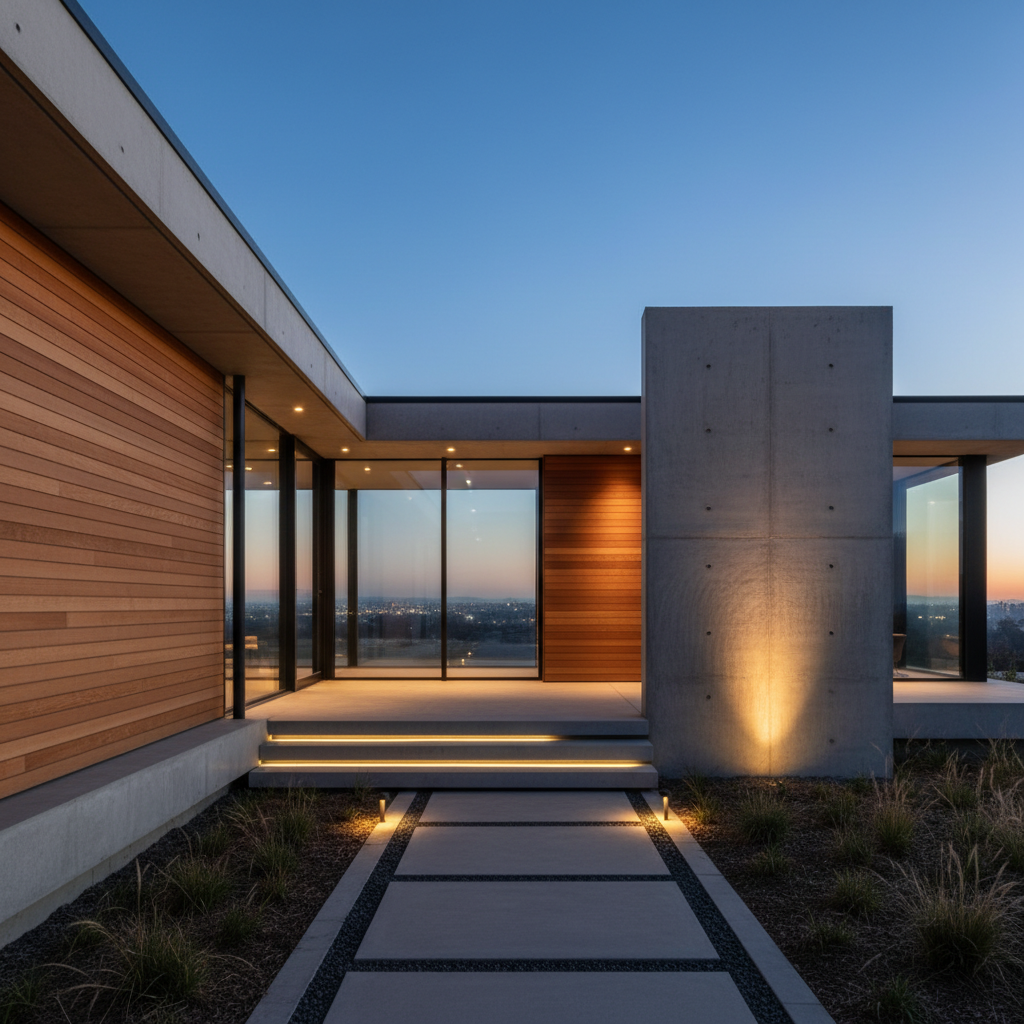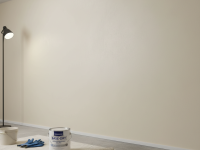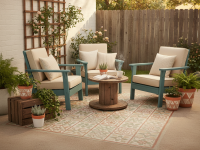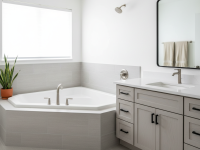Hey there, fellow design enthusiasts! If you’re anything like me, you appreciate the clean lines, the thoughtful simplicity, and the serene vibe that a modern minimalist home brings. It’s not just a style; it’s a lifestyle, an ode to purposeful living. But let’s be honest, sometimes outdoor spaces get a bit neglected when it comes to lighting, or worse, they get over-lit in a way that clashes with that very minimalist ethos.
From my own experience working with homeowners and even sprucing up my own patio, I’ve seen firsthand how the right outdoor lighting can transform a space. It’s not just about visibility; it’s about extending your living area, enhancing the architecture you’ve meticulously chosen, and creating a truly welcoming, secure, and beautiful environment once the sun goes down. In a minimalist home, every element counts, and lighting is no exception. It should blend seamlessly, serve a purpose, and subtly elevate your home’s aesthetic.
So, let’s dive into how we can perfectly illuminate your modern minimalist sanctuary, making it shine (literally!) with purpose and style. Trust me, it’s easier and more impactful than you might think!
What Defines “Minimalist” Outdoor Lighting?
Before we start picking out fixtures, it’s crucial to understand what “minimalist” means in the context of outdoor lighting. It’s not about having *no* lights; it’s about having *the right* lights in *the right places*. Here are a few defining characteristics:
- Less is More, Always: This is the golden rule. Avoid clutter, visible wires, and an excessive number of fixtures. Each light should justify its existence.
- Clean Lines and Discreet Fixtures: Think sleek, understated designs that blend into the architecture or landscape rather than standing out as ornate features. Integrated lighting is your best friend here.
- Focus on Function and Subtle Enhancement: Lighting should primarily serve a purpose – safety, pathway illumination, highlighting a specific architectural detail – and do so without screaming for attention.
- Warm, Inviting Light Temperature: While bright white might feel “modern,” a warmer glow (around 2700K-3000K) often creates a more inviting and sophisticated atmosphere, complementing natural materials common in minimalist design.
- Integration, Not Addition: The best minimalist lighting feels like an extension of your home’s design, not an afterthought.
Core Principles for Illuminating Your Minimalist Outdoor Space
When I approach any outdoor lighting project, I always start with a few foundational principles. These will guide your choices and ensure your lighting scheme truly embodies the minimalist spirit.
1. Function First: Identify Your Needs
Before you even think about aesthetics, ask yourself: What absolutely needs to be lit?
- Safety: Pathways, steps, entry points, areas around pools or fire pits.
- Security: Deterring unwanted visitors by illuminating dark corners, garage areas, and main entrances.
- Usability: Lighting for outdoor dining areas, lounges, or kitchen spaces.
- Navigation: Clearly defining routes to your front door or specific garden features.
Once you know where light is essential, you can then consider how to make those lights minimalist and beautiful.
2. Highlight, Don’t Overwhelm: Accentuate Features
Minimalist design is about emphasizing the beauty of simple forms and materials. Your lighting should do the same. Use light to draw attention to:
- A textured concrete wall or a striking wood panel.
- A sculptural tree or a carefully curated planting bed.
- The unique lines of your home’s facade.
The goal isn’t to blast everything with light, but to create focal points and intriguing shadows. Think of it as painting with light and shadow – the shadows are just as important as the light itself.
3. Layering Light for Depth (Minimally!)
Even in a minimalist design, layering is key to creating a rich, inviting atmosphere. You’ll typically want a combination of:
- Ambient Light: General, soft illumination that sets the mood and provides overall visibility. This could come from discreet wall washes or integrated deck lighting.
- Accent Light: Focused light to highlight specific architectural features, plants, or art. Uplights and spotlights fall into this category.
- Task Light: Brighter, more direct light for specific activities, like grilling or reading on the patio. This needs to be carefully integrated to avoid looking cluttered.
The trick for minimalism is to achieve these layers with as few visible fixtures as possible, often using multi-functional lights or very subtle integrations.
4. Embrace Warmth and Thoughtful Color Temperature
I find that for most modern minimalist homes, especially those incorporating natural materials like wood, stone, and concrete, a warmer light temperature (2700K to 3000K) is ideal. It evokes a sense of comfort and sophistication, making your home feel more welcoming. Anything above 3500K can start to feel a bit too stark or “commercial” for a residential setting, detracting from that serene vibe you’re aiming for.
5. Discreet Fixtures: The Unsung Heroes
The best minimalist outdoor light fixtures are often those you barely notice during the day. Look for:
- Recessed Lights: Perfect for steps, deck surfaces, soffits, and walls. They disappear into the structure.
- Sleek Wall Sconces: Choose fixtures with simple geometric shapes, often in black, dark gray, or brushed metal finishes, that project light up, down, or both, without being overly decorative.
- Low-Profile Bollards or Path Lights: When you need path lighting, opt for very slender, short fixtures that emit light downwards to avoid glare and keep the focus on the path, not the fixture itself.
- Integrated Strip Lighting: Great for under benches, along railings, or tucked into architectural reveals to create a soft, continuous glow.
Specific Lighting Ideas for Different Outdoor Zones
Now, let’s get practical! Here’s how these principles translate into specific areas of your minimalist outdoor space.
The Grand Entrance & Pathways
Your entryway is the first impression, and pathways guide visitors.
- Floating Steps & Recessed Lighting: If you have modern floating steps, integrate strip lighting underneath for a dramatic, ethereal glow that also clearly defines each step. For solid steps, small, square recessed step lights are perfect.
- Sleek Wall Washers: Instead of traditional sconces, consider small, upward or downward-facing wall washers on either side of your front door to softly illuminate the entrance and facade.
- Subtle Path Markers: For long pathways, use very low-profile bollard lights or inground path lights that are flush with the ground. Their primary function is to delineate the path safely, not to be a garden ornament.
Highlighting Architectural Marvels
This is where your home’s unique design truly comes alive at night.
- Uplighting Facades: Place narrow-beam uplights at the base of striking walls or architectural pillars. This creates dramatic shadows and highlights texture beautifully.
- Grazing Light: For textured surfaces like stone or corrugated metal, position a light fixture very close to the wall (within 6-12 inches). This “grazing” effect emphasizes the material’s texture.
- Soffit Lighting: If your home has extended eaves or soffits, recessed LED strip lighting can provide a wonderful, uniform ambient light that washes down the side of the house without any visible fixtures.
Minimalist Landscape & Garden Illumination
Your landscape should complement your home, not compete with it.
- Subtle Tree Uplighting: Choose a few key trees or tall shrubs and use discreet spotlights at their base to highlight their form and texture. Avoid over-lighting every plant.
- Integrated Deck & Patio Lighting: Recessed LED disc lights or strip lights along the edges of decks, built-in benches, or under railings provide safety and ambient light without clutter.
- Water Feature Glow: If you have a minimalist water feature, a single submerged spotlight can create a captivating effect, highlighting the movement and texture of the water.
Patios & Outdoor Living Areas: Your Evening Retreat
This is where you’ll spend your evenings, so comfort and atmosphere are key.
- Dimmable Overhead Lighting: If you have a covered patio, a simple, geometric pendant light or recessed downlights (on dimmers!) can provide versatile ambient light.
- Linear String Lights (Thoughtfully Used): While often associated with a more bohemian look, minimalist string lights (think small, warm white bulbs on a dark, thin wire) can be strung cleanly across a patio to create a charming, understated canopy.
- Integrated Seating Lighting: If you have built-in outdoor seating, LED strips underneath the benches can create a floating effect and provide soft, ambient light.
Remember, dimmers are your best friend here! They allow you to adjust the mood from bright functional light to a soft, romantic glow.
Smart Lighting: The Ultimate Minimalist Touch
For a truly modern minimalist home, smart lighting isn’t just a gimmick; it’s an essential tool.
- Seamless Control: Manage all your outdoor lights from your phone, a smart home hub, or even voice commands. No need for multiple switches or clunky timers.
- Automation: Schedule lights to turn on at dusk and off at dawn, or to activate when motion is detected for security.
- Efficiency: LED smart lights are incredibly energy-efficient, saving you money and being kind to the planet.
- Scene Setting: Create different “scenes” for entertaining, relaxing, or security, and switch between them with a single tap.
This level of control and integration truly aligns with the minimalist desire for efficiency and an uncluttered experience.
Common Pitfalls to Avoid in Minimalist Outdoor Lighting
Even with the best intentions, it’s easy to make mistakes that compromise the minimalist aesthetic. Here are a few things I always caution against:
- Over-lighting: Too many fixtures, or fixtures that are too bright, will instantly detract from the serene, sophisticated look you’re aiming for. It creates a “runway” effect rather than an inviting home.
- Visible Wires & Clutter: Nothing screams “not minimalist” louder than wires strung haphazardly or bulky fixtures that don’t blend in. Plan your wiring carefully, burying it or integrating it seamlessly.
- Ignoring Glare: Ensure your lights are directed downwards or shielded to prevent blinding glare, which is both uncomfortable and unsightly.
- Wrong Color Temperature: As mentioned, overly cool or “blue” light can make your home feel sterile rather than welcoming. Stick to warmer tones.
- Neglecting Maintenance: Even the sleekest fixture will look bad if it’s covered in dirt, cobwebs, or if bulbs are out. Regular, simple maintenance is key.
Conclusion: Light Your Way to Serenity
Designing outdoor lighting for a modern minimalist home is about thoughtful intention and strategic placement. It’s not about absence, but about precision. By focusing on function, embracing subtle enhancements, and choosing discreet, well-placed fixtures, you can transform your outdoor spaces into beautiful, secure, and highly functional extensions of your home.
From my perspective, the true beauty of minimalist outdoor lighting lies in its ability to highlight the inherent elegance of your home’s architecture and landscape without overpowering it. It’s about creating an atmosphere that enhances your sense of peace and pride in your living space. So, take these ideas, plan carefully, and get ready to enjoy the stuing glow of your beautifully lit minimalist sanctuary!




